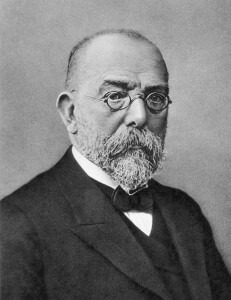
In a perspective recently published in Science magazine, scientists Allyson Byrd and Julie Segre from the National Human Genome Research Institute used recent advances in microbial analysis to look at Koch’s postulates through a new lens.
Published by Robert Koch in 1890, these principles have become widely accepted in microbiology as the definitive means to prove that a specific pathogen is the cause of an infectious disease. As summarized by Byrd and Segre, the postulates dictate that: “First, the microorganism occurs in every case of the disease; second, it is not found in healthy organisms; and third, after the microorganism has been isolated from a diseased organism and propagated in pure culture, the proposed pathogen can induce disease anew.”
The authors point out that Koch lived long before the discovery of antibiotics and nucleic acids, noting that recent revelations in infectious disease research call for an update of these principles — specifically, the role of microbial communities in causing or preventing disease. “In light of recent appreciation of microbial consortia, the scientific community should consider infectious disease causation in a broader systems biology context in which host genetic variability, health status, past exposure history, and microbial strains and communities are all important,” Byrd and Segre write. “As technology advances and new scientific discoveries are made, we must dynamically adapt Koch’s postulates so today’s science maintains the integrity that Koch originally fostered.”
The authors review several recent infectious disease papers, noting that hospital-acquired infections and microbiome studies have both shed new light on the association between microbes and disease. For instance, certain commensal microbes appear to protect against infections like those caused by Clostridium difficile, Salmonella, and other pathogens. Microbes can also work together to prevent infection, as seen in recent work demonstrating that a six-member microbial community ameliorated the effects of C. difficile infection, the authors report. “These findings force us to consider under what circumstances a consortium of microbes can fulfill Koch’s postulates,” they add. “For example, do all members of the community have to be grown in pure culture and tested individually, or is it sufficient to grow and test a group culture?”
Byrd and Segre note that new sequencing technologies have made it possible to study and analyze microorganisms that cannot be cultured. They also recommend updates to Koch’s postulates that would expand the rules to cover microbial communities.
SMRT Sequencing provides a high-resolution view that allows scientists to interrogate microbes — both individually and in communities — with greater accuracy and completeness than has ever been possible before. It’s an honor to see so many PacBio users delivering new insights that surely would have made Koch proud.
February 25, 2016 | General